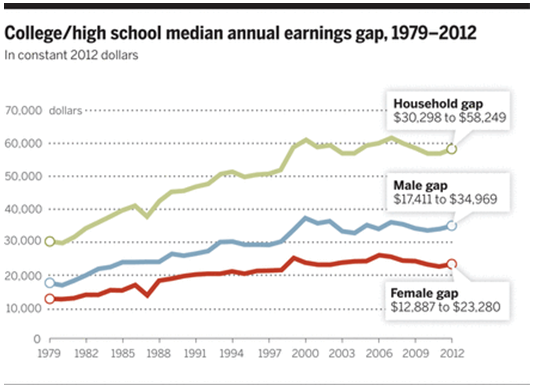Public debates about income inequality have focused on the gaps in income between the very top and the rest of the public, but, as David Autor writes in a recent article for Science, the dramatic growth in the earnings premium for college graduates is “a component of rising inequality that is arguably even more consequential” for the average American than the rising incomes among the top 1%. Unfortunately, “the 31%” doesn’t have quite the same ring as “the 1%”. (Check out the whole issue of Science, devoted to issues of inequality and mobility).
A growing education divide
The college-high school annual earnings gap has almost doubled for households since 1979. Higher returns to postsecondary education account for more than half of the rise in wage inequality for men from 1973 to 2005.

High returns to education reinforce class and income divides
Autor describes the relationship between educational earnings gaps and mobility as follows:
“Why, if education is “the great equalizer” in the words of Horace Mann, do high educational returns predict low mobility? A key reason is that educational attainment is highly persistent within families. … Hence, when the return to education is high, children of better-educated parents are doubly advantaged—by their parents’ higher education and higher earnings—in attaining greater education while young and greater earnings in adulthood.”
More readings on the role of educational attainment in social mobility
- An overview of education and economic mobility
- The opportunity gap for higher education
- 47% of kids who have a strong grades in high school and enroll in post-secondary education are in the top income quintile by middle age
- The College Bottleneck: what it is and whether it has value
- Does College Really Improve Social Mobility?
- Ways to improve higher education to improve mobility



Commentary
The Great Divider: Education, Class and Inequality
May 27, 2014